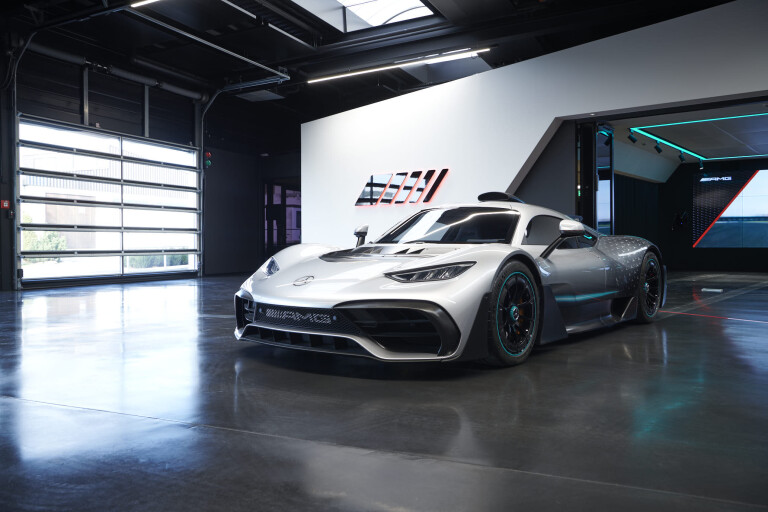
The AMG Performance Studio is tucked away in an anonymous building deep within the brand's all-white Affalterbach complex. Segmented to demand by moving dividers and more black curtains than dangling from the entrance to hell, this sparsely lit facility is split into a large viewing area complete with turntable and a lounge section with enough room for a couple of cars.
We are being met by Michael Gleinser, who could be described as salesman to an elite group of customers, except that he is more of a diplomatic and mediating allocator of very special motor cars that are in notoriously short supply.
Examples include every single Black Series model AMG ever built, and the limited-edition AMG One that competes in an impossibly elusive segment the Mercedes power brokers will for various reasons never, ever target again.
First unveiled at the Frankfurt show in 2017 as AMG Project One, the mission of the marque's second hypercar after the stillborn C112 buried in 1992 and the 1998 AMG GLK GTR built by Lola was to create the closest thing to a street-legal Formula 1 racer.

In cooperation with Multimatic Special Vehicle Operations, a Canadian R&D think tank with a UK assembly satellite, the former AMG CEO and subsequent head of Aston Martin, Tobias Moers, set out to transfer the fascination relayed by the championship-winning race car to a small batch of ultra-high-end sportscars.
In retrospect, Moers, Ola Källenius who oversaw AMG at the time, and the Mercedes top management must have regretted this step more than once, but with the brand's reputation, a substantial up-front investment and 275 potentially miffed customers at stake, pulling out was not an option. AMG therefore swallowed the pill and paid dearly for the most long-winded gestation process in corporate history.
Even now, in March 2022, almost five years after the initial announcement, the vehicle on display is not yet the final item. Early real-world high-speed tests made it clear that the aero pack still needed more work, which includes for example the more extreme front bumper and the steeper-angled active rear spoiler.
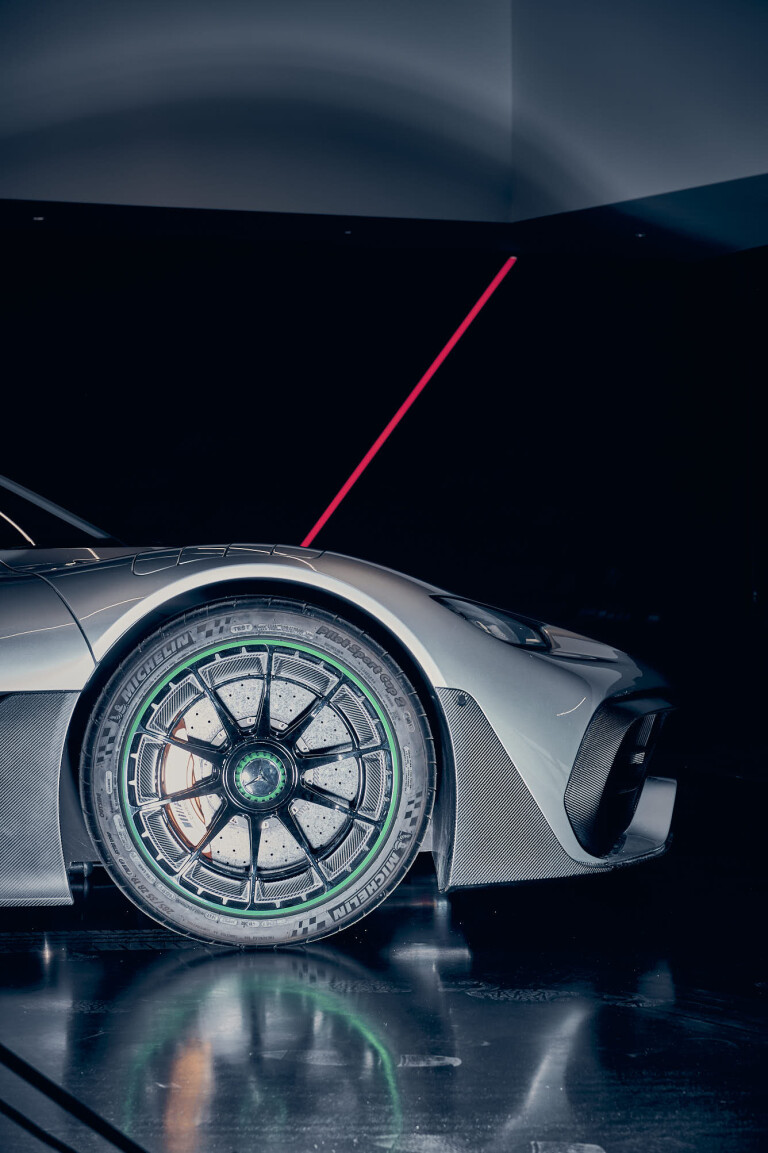
These last-minute anti-lift, pro-downforce measures glaze only the tip of a huge headache iceberg that materialised weeks after the project was kicked off. Detuning the small 1.6-litre V6 that needs 14 specialist F1 mechanics to prepare the short roll-out from garage to pit lane was no mean feat to start with.
Bringing the redline from 14,000rpm down to 11,000rpm was easy, but reducing the 4000rpm idle speed to a CO2-compatible level was not. In production trim, the One must therefore carry 16 heating elements at 1kW each spread over its fat catalytic converters.
To comply with legislation, every cold start manoeuvre is therefore a test of patience, especially in winter. Alternatively, instant take-off is possible in eDrive, but only if the batteries are charged, and only for 16km at the most.
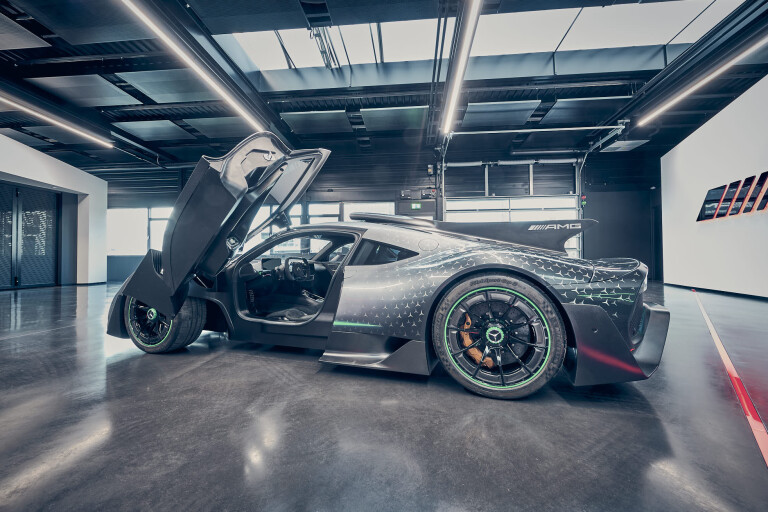
Despite the relatively subtle silver-over-grey livery with Petronas Green accents, the One does look like a potential troublemaker and road rage purveyor even in concept car guise.
The marginal ground clearance and the matching ramp angle shout 'caution!' while the precious magnesium rims stick out like raw diamonds waiting to be cut by angry kerbs, the longitudinal rear fin and wingwork reduce the rear visibility to nil, and the brutally vulnerable overhangs need a crunch-protection guide drone to survive in dense traffic.
On the track, the driver may be able to cope with such extremes. But on the open road? In town? On crumpled B-roads? Through towering toll gates? Over speed bumps? You get used to it, claims our friendly Personal Liaison Manager, even though he has yet to sample his latest pet object of desire, envy and, probably, hate.
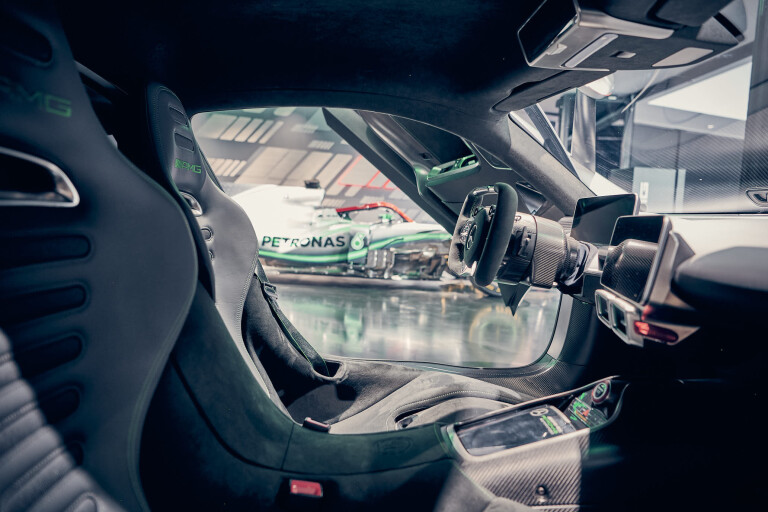
Time for the first fitting. Opening the heron-wing driver door thankfully removes part of the roof and the entire sill, thereby creating an aperture large enough even for a big and tall person.
While the Aston Valkyrie is so tight a fit it almost hurts, the One is at least roomy enough for the head to remain on top of the shoulders, the legs to sort themselves out in the shallow but long enough charcoal cellar, and the arms to clear all interfering panels when making contact with the neo-quartic steering wheel.
One sits two inches above the tarmac in a sufficiently wide fixed leather-trimmed bucket that won't squeeze the kidneys out of the torso, thank you very much, but the lower limbs may at first struggle with the pedal box, which can be pushed forward by pulling a lever next to the crown jewels.

The steering column pulls out and moves up or down with due generosity, so yes, we could actually, eventually become friends, the ultimate starship and its wannabe owner.
The sparse cockpit is equipped with two rectangular displays, one for speed, revs, gear position and lap times, the other for sat-nav, energy flow and infotainment. The dominating element is nonetheless the oddly shaped steering wheel that shares its fingertip control pads with the current E-Class as though some kind of peace-making gesture.
New additions to the rim are four prominent yellow, red, green and blue drive mode buttons as well as a row of LED rpm indicators, plus the manual mode activator, the ESP Off button and the eight-step traction control thumbwheel. The starter knob sits on the centre console right above the secondary switchgear.

Also on board is the latest version of MBUX, but the voice control feedback may drown in a decibel tsunami when the engine is running on full song. Even though air-conditioning is standard, the anti-perspiration effect generated by the two small centre outlets won't match the cooling power of an S-Class system.
The low-slung cabin is clad in a tasteful mix of leather and Alcantara, complemented by various carbonfibre details – shiny or matte, no extra charge – that hammer home the car's motor racing roots.
What about extras, personalisation, special requests, Herr Gleisner? "The most popular option is the Motorsport Styling Pack priced at €85K plus tax. It offers a choice of three different bespoke F1-inspired liveries boasting unique star patterns, colour schemes and authentic F1-quality paint. Matching these outfits are lightweight magnesium wheels at €41.5K per set."
Converted to Australian dollars, these options are $126K and $61K respectively!
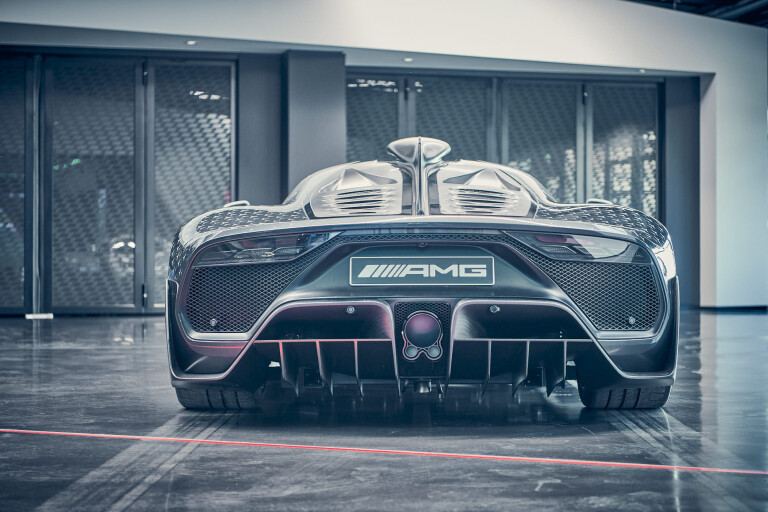
AMG will spray any of five standard colours free of charge, but the matte Magno finish costs €11,354 (AU$16,900) – plus tax – extra. The official price list shows only five more items: winter tyres on special wheels at €19.5K (AU$29K) per shot, four slicks on bespoke alloys for €27.5K (AU$41K) net, an indoor car cover, six-point harness, special number plate holders and no AMG logo on the nasal air intake.
Included in the purchase price are the mandatory front axle lift, knee bolsters, window bags and front airbags as well as parking aids and an extensive multi-step introduction and familiarisation session complete with driving instructor prior to the first track-day outing.
If you dislike the all-black interior, the duo-tone hide upholstery with contrasting stitching is a brighter alternative at €28.5K (AU$42K). Michael Gleisner refuses to quote the exact price for a paint-to-sample finish, but he confirms that any historic Mercedes colour, Maybach hue and Magno shade is readily available.
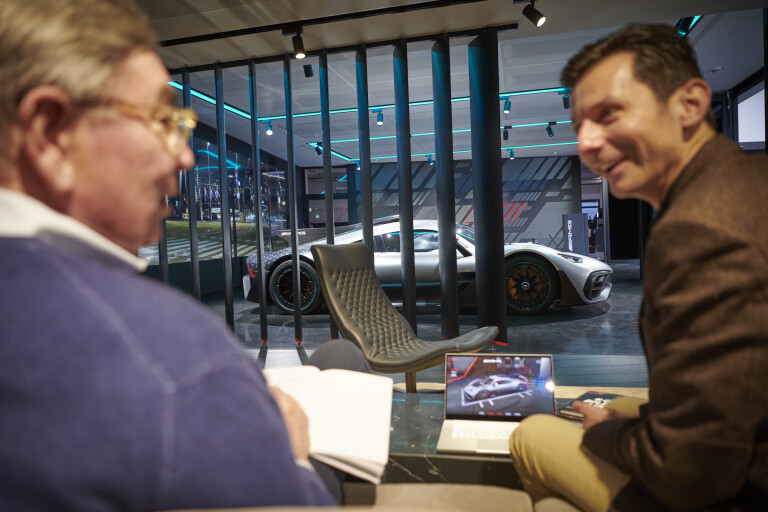
"We will even spray the car Ferrari red, but hurt pride would inflict a still to be determined disloyalty payment."
Sounds like a joke yet isn't. "What is your colour preference, sir?" Sir does not mind the black interior, but a friendly pastel blue exterior from the 1960s would make a nice contrast to all the go-faster reds, yellows and silvers, wouldn't it?
"Absolutely. You may be interested that we also offer an exact replica of the historic gunmetal shade to which the silver arrows owe their name."
Names of the confirmed future owners are of course top secret, but it is common knowledge that racing drivers like Hamilton, Rosberg and Coulthard are on the list. Niki Lauda on the other hand has passed away since placing an order, quite a few oligarchs are bound to cancel due to the war, and since not every start-up hero will pull through either, AMG is constantly updating the relatively long list of second-chance candidates.

The first customer car is now due to be delivered in August, which suggests that all 275 units should arrive at their homes by the end of 2024. Since early cars are being advertised at up to €1.5m (AU$2.2m) above list, Mercedes has imposed a minimum keep period along with heavy infringement fines.
Every customer must travel to Affalterbach to go through the configuration process, sign the contract and pick up the finished vehicle. In mid-May, the first lucky few will be invited to Madrid Jarama for a three-day event that includes a ride in the car, an extensive tech briefing pus drives in the new SL and AMG GT63 S E-Performance.
What kind of hypercar exactly is the AMG One? Carbonfibre is quite obviously the material of choice, which was mandatory to reach the alleged target weight of 1250kg.
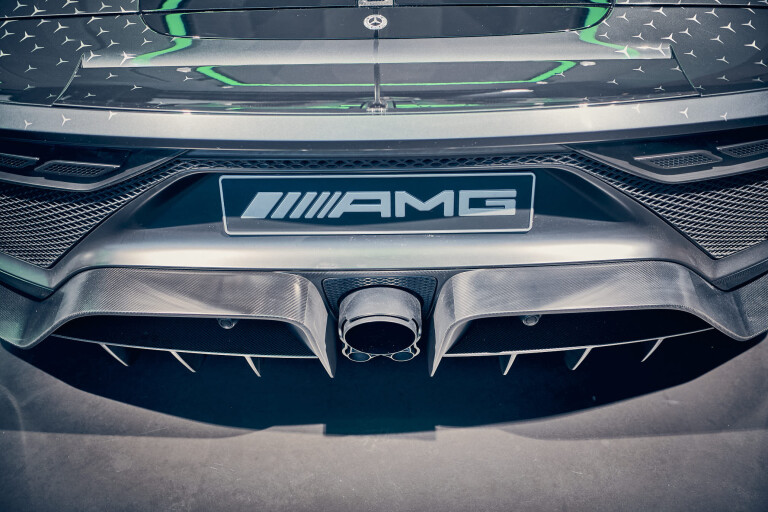
The combined power output is said to be 786kW. It is generated by the single-turbo small displacement V6 in conjunction with four e-motors redlined at 50,000rpm: two 122kW units drive the front wheels, a third 122kW module grabs the crankshaft via a micro gear assembly, and finally there is a zero-lag 91kW electric whip integrated into the turbocharger housing.
Three of the four motors can switch freely between propulsion and regeneration. If you consider this arrangement to be super complicated, check out the three separate electrical orbits that will take you to an even higher level of complexity. In addition to the indispensable 12V circuit, the One also relies on 48V assistance to pre-heat the catalysts as well as an 800V system to feed the batteries.
Five driving programmes are reportedly labelled eDrive, Hybrid, Sport, Race and STRAT2. The latter equals the hyper mode reserved for the third and final F1 qualifying session when the driver can for one lap or two summon extra power and grunt.
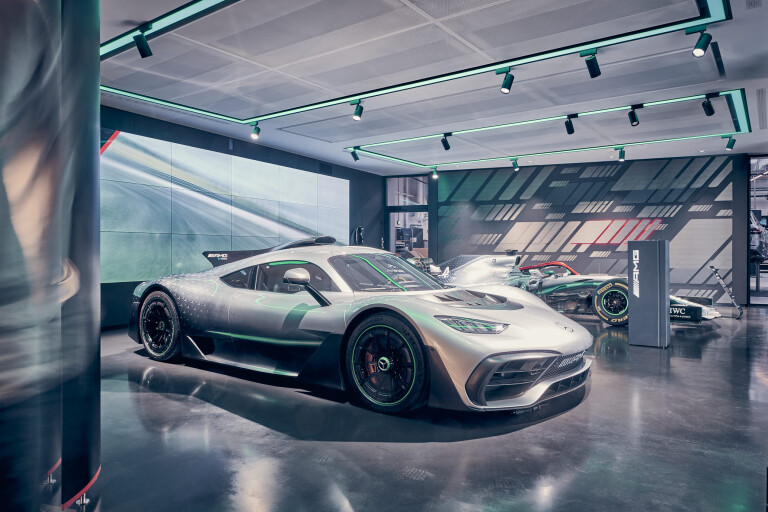
While the front wheels are battery-driven on demand, torque is channelled to the rear wheels by an automated eight-speed dual-clutch transmission courtesy of X-Trac. Together, the two drive modules are claimed to introduce a more advanced level of faster, more precise and more dynamic torque vectoring.
According to a test driver, the pneumatic valve springs start cackling above 8500rpm, the spur gears begin to sound like sewing machines on steroids, and the timing chains hum, buzz and drone eerily close to the firewall.
"This car is not so much about the 0-100km/h acceleration time," states our friend from sales and marketing.
"Instead, its prime strength is the virtually unrivalled dynamic supremacy throughout the entire speed and rev range, both on and off-circuit."
Be that as it may, the rumoured 2.5sec 0-100km/h sprint time is not to be scoffed at, the unofficial 5.9sec for the 0-200km/h run is even more mind-boggling, and the top speed of over 354km/h leaves the Bugatti Chiron Super Sport as the only old world rival and the Rimac Nevera as the chief new world contender.

COMMENTS